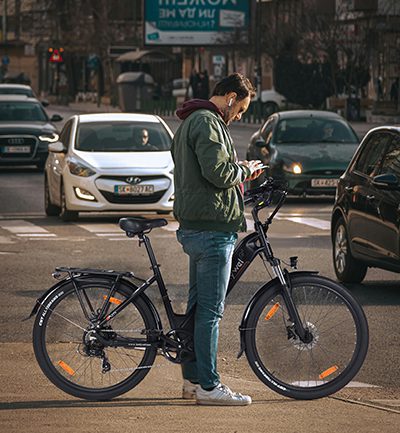Electric bicycles, or e-bikes, have surged in popularity over the last decade, transforming how we think about urban mobility, fitness, and leisure. This blog will delve into the benefits of e-bikes, the features you should look for, and guide you on how to choose the right one for your needs.
Benefits of E-Bikes
- Environmental Impact:
- Reduced Carbon Footprint: E-bikes produce zero emissions, contributing to cleaner air in urban environments. They offer an alternative to car travel for short distances, significantly reducing individual carbon footprints.
- Health and Fitness:
- Adjustable Assistance: With variable levels of pedal assist, e-bikes make cycling accessible to a broader audience, including those who might not have the stamina for traditional biking. Yet, they still require physical effort, to promote cardiovascular health.
- Convenience:
- Ease of Commuting: E-bikes can take you further with less effort, making them ideal for commuting. They can navigate through traffic with ease, often providing quicker travel times than cars in congested cities.
- Cost-Effective:
- Savings on Transport: Compared to cars or even public transport, e-bikes are economical in terms of fuel, maintenance, and parking costs.
Key Features of E-Bikes
- Motor:
- Power and Placement: Motors vary from 250 to 750 watts, with some high-end models offering more. Placement can be front, rear, or mid-drive, affecting the bike’s balance and handling.
- Batería:
- Range and Charging: Battery capacity determines how far you can go before needing a recharge. Look for batteries with good mileage and reasonable recharge times. Removable batteries are a plus for convenience.
- Pedal Assist Levels:
- Adjustability: Most e-bikes come with multiple levels of assistance, allowing you to tailor the bike’s performance to your fitness level or the terrain.
- Brakes:
- Safety First: Opt for e-bikes with reliable hydraulic disc brakes or at least high-quality mechanical disc brakes for better control and safety.
- Frame and Design:
- Comfort and Style: Choose a frame that fits your body size for comfort. Consider the design for your intended use – step-through for ease of mounting, or full suspension for rugged terrains.
Cómo elegir la bicicleta eléctrica adecuada
- Define Your Use:
- Commuter, Mountain, or Cruiser? Different bikes serve different purposes. A commuter might need a lightweight, easy-to-maneuver bike, while a mountain e-bike would require robust suspension.
- Presupuesto:
- Quality vs. Cost: Higher-priced e-bikes often come with better components, longer-lasting batteries, and more sophisticated technology. However, there are budget models that serve well for casual use.
- Prueba de conducción:
- Feel the Bike: If possible, test-ride different models. Comfort, handling, and the feel of the motor assistance are crucial for satisfaction.
- Maintenance and Support:
- After-Sale Service: Check the availability of parts, service centers, and the brand’s reputation for support.
- Legal Considerations:
- Local Regulations: E-bikes are regulated differently around the world. Ensure your choice complies with local laws regarding speed, where you can ride, and helmet requirements.
Conclusión
E-bikes offer a blend of traditional cycling with modern technology, providing a practical, fun, and environmentally friendly mode of transport. Whether you’re looking to reduce your commute time, explore more of the outdoors, or simply enjoy a new way to exercise, there’s an e-bike suited for you. By understanding the benefits, focusing on key features, and matching your needs with the right model, you’re well on your way to embracing the e-bike revolution.
Remember, if you need visual aids to understand different types of e-bikes or want to see how they look in action, I can generate images to help illustrate this further.


